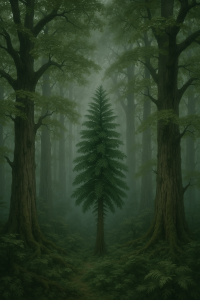
A Wollemi pine stands tall in the mist, a living echo of prehistoric times.
Trees That Time Forgot: A Journey Through Prehistoric Forests
Some trees don’t just grow tall. They hold time in their branches. They remember. You can feel it when you stand beneath them—the hush, the hush that stretches across epochs. These aren’t your everyday maples or magnolias. These are the trees that have seen worlds come and go. They are living fossils, quiet witnesses to a planet that has changed many times, and somehow, they are still here.
Far away in a hidden canyon in Australia, a small group of strange pines was found not too long ago. Their bark looked like bubbling puzzle pieces, their limbs filled with fern-like leaves that seemed plucked from a dream. Scientists named them Wollemi pines, and they couldn’t believe their eyes. These trees were thought to have disappeared millions of years ago, known only from ancient fossils. And yet, there they were, swaying gently in the breeze like nothing had ever happened. The world had gone through ice and fire, but they had kept growing in their quiet corner.
Then there’s the dawn redwood, which once blanketed vast stretches of the northern world before it vanished from sight. Thought extinct until the 1940s, it reappeared in a misty village in China, still shedding its needles each fall, still growing with calm elegance. Standing beneath one feels like standing at the edge of a story that never really ended. Its rust-colored canopy glows in the afternoon sun, softening the sky above with warmth and age.
The ginkgo tree is another traveler from the deep past. Its fan-shaped leaves flutter like pages from an old book, and those pages haven’t changed much in over 200 million years. These trees saw the rise and fall of dinosaurs, and they’ve stood in temple courtyards for centuries. In Hiroshima, some even survived the unthinkable. Their bark was scorched, but new leaves emerged just months later. You don’t forget a tree like that. It teaches something without words—about resilience, about holding on, about beginning again even when the world seems lost.
And long before any of these still-standing elders, there were giants with strange names and stranger forms. Ancient tree-like plants that weren’t quite trees as we know them now, but their roots made soil and their leaves created shade. They changed the land just by being there. They were the first to stretch upward and say, “Let’s try this.” And in doing so, they carved out the blueprint of what forests would someday become.
These prehistoric trees matter not just because they are old, but because they are alive. They are nature’s memory. Their survival isn’t flashy. It’s quiet. They don’t demand attention, but they deserve it. They’ve seen mass extinctions, shifting continents, ice ages, and warming skies. And yet, they persist. Their leaves still catch the light. Their roots still hold the ground. They remind us that survival is often slow, and strength doesn’t always shout.
The beautiful thing is that you can actually plant some of them in your own backyard. Ginkgo saplings grow gracefully and require little fuss. Dawn redwoods shoot up quickly, green and eager in the spring sun. And while Wollemi pines are protected and rare, you can still find them through special nurseries. Imagine tending to a tree whose ancestors watched the dinosaurs walk by. Imagine being part of its ongoing story.
Next time you pass a tree that feels a little different, a little older in its spirit, take a moment. Maybe it’s a ginkgo rustling in the breeze or a redwood lifting its head above the rooftops. Maybe it’s a reminder that time isn’t only in clocks and calendars. Sometimes it’s standing still, wearing bark, and holding the sky.
Did You Know?
![]()
The Wollemi pine was thought extinct for over 90 million years until it was discovered in 1994 in a remote canyon in Australia. Fewer than 100 mature specimens exist in the wild.
FAQs About Dancing Trees
What exactly is a “living fossil” tree?
A living fossil is a species that has remained virtually unchanged for millions of years and closely resembles its fossilized ancestors. These trees offer a glimpse into Earth’s prehistoric past and how life once thrived.
Can I grow a prehistoric tree at home?
Yes! Species like ginkgo trees and dawn redwoods are available at many nurseries and can thrive in a variety of climates. They’re surprisingly low-maintenance and make a meaningful addition to any garden.
What makes the Wollemi pine so rare and special?
The Wollemi pine is one of the rarest trees in the world. It was only known from fossils until its discovery in Australia in the 1990s. It reproduces both by seed and by sprouting new shoots, and it’s strictly protected due to its conservation status.
Have questions about the trees in your own yard?
Tip Top Arborists is here to help you care for your living legends. Let our certified arborists provide expert guidance for a lifetime of healthy trees.
